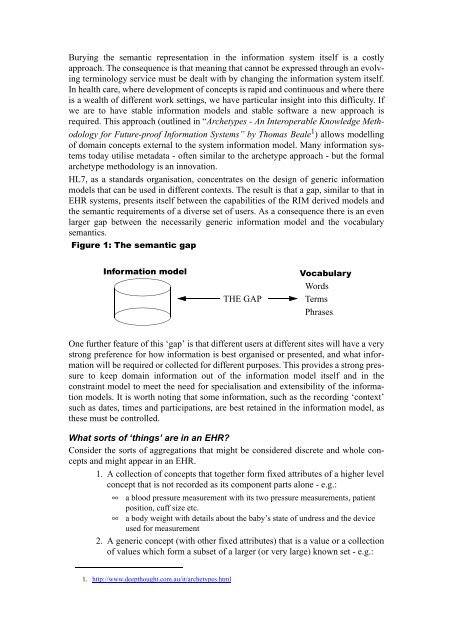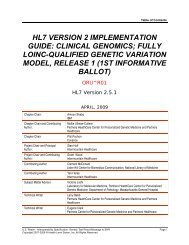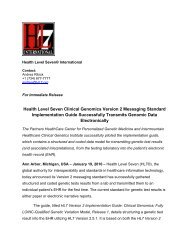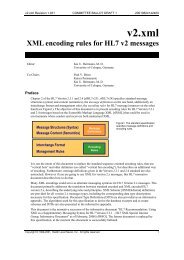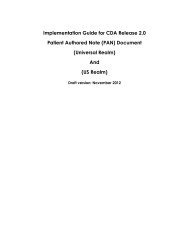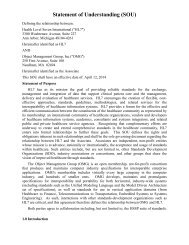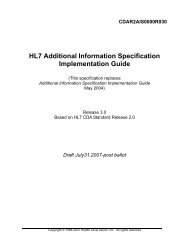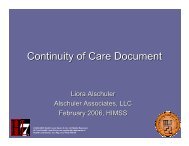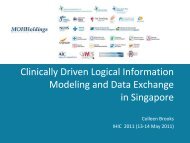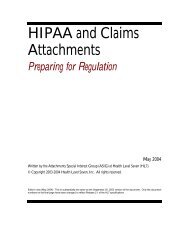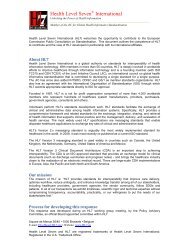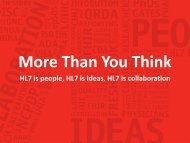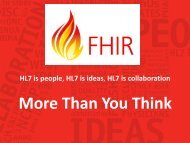Templates and Archetypes GF.fm - HL7
Templates and Archetypes GF.fm - HL7
Templates and Archetypes GF.fm - HL7
Create successful ePaper yourself
Turn your PDF publications into a flip-book with our unique Google optimized e-Paper software.
Burying the semantic representation in the information system itself is a costlyapproach. The consequence is that meaning that cannot be expressed through an evolvingterminology service must be dealt with by changing the information system itself.In health care, where development of concepts is rapid <strong>and</strong> continuous <strong>and</strong> where thereis a wealth of different work settings, we have particular insight into this difficulty. Ifwe are to have stable information models <strong>and</strong> stable software a new approach isrequired. This approach (outlined in “<strong>Archetypes</strong> - An Interoperable Knowledge Methodologyfor Future-proof Information Systems” by Thomas Beale 1 ) allows modellingof domain concepts external to the system information model. Many information systemstoday utilise metadata - often similar to the archetype approach - but the formalarchetype methodology is an innovation.<strong>HL7</strong>, as a st<strong>and</strong>ards organisation, concentrates on the design of generic informationmodels that can be used in different contexts. The result is that a gap, similar to that inEHR systems, presents itself between the capabilities of the RIM derived models <strong>and</strong>the semantic requirements of a diverse set of users. As a consequence there is an evenlarger gap between the necessarily generic information model <strong>and</strong> the vocabularysemantics.Figure 1: The semantic gapInformation modelTHE GAPVocabularyWordsTermsPhrasesOne further feature of this ‘gap’ is that different users at different sites will have a verystrong preference for how information is best organised or presented, <strong>and</strong> what informationwill be required or collected for different purposes. This provides a strong pressureto keep domain information out of the information model itself <strong>and</strong> in theconstraint model to meet the need for specialisation <strong>and</strong> extensibility of the informationmodels. It is worth noting that some information, such as the recording ‘context’such as dates, times <strong>and</strong> participations, are best retained in the information model, asthese must be controlled.What sorts of ‘things’ are in an EHR?Consider the sorts of aggregations that might be considered discrete <strong>and</strong> whole concepts<strong>and</strong> might appear in an EHR.1. A collection of concepts that together form fixed attributes of a higher levelconcept that is not recorded as its component parts alone - e.g.:∞ a blood pressure measurement with its two pressure measurements, patientposition, cuff size etc.∞ a body weight with details about the baby’s state of undress <strong>and</strong> the deviceused for measurement2. A generic concept (with other fixed attributes) that is a value or a collectionof values which form a subset of a larger (or very large) known set - e.g.:1. http://www.deepthought.com.au/it/archetypes.html


